SECTION I
RESEARCH AND METHODOLOGIES
The effect of brushing motion on the cyclic fatigue of rotary nickel titanium instruments
Effetto del movimento di brushing sulla fatica ciclica di strumenti rotanti nichel titanio
Gianluca GambariniI; Eugenio TucciI; Rossella BediniII; Raffaella PecciII; Massimo GalliI; Valerio MilanaI; Massimo De LucaI; Luca TestarelliI
IDipartimento di Scienze Odontostomatologiche, Sapienza Università di Roma, Rome, Italy
IIDipartimento di Tecnologie e Salute, Istituto Superiore di Sanità, Rome, Italy
SUMMARY
The goal of the study is to evaluate if the use of rotary nickel-titanium (RNT) instruments, as Hedstroem files, is safe. Twelve twisted files (TF) RNT instruments size 06-25 were selected and randomly divided in 2 groups of 6 instruments each. Group A (new instruments) were used as control. Group B (test) instruments were clinically used only as Hedstroem files in a canal that had been previously instrumented to the working length with other 06-25 RNT instruments. Group B instruments were used only in the straight portion of the canal (1 minute at 1000 rpm). A cyclic fatigue test was performed for each instrument of groups. Data were statistically analyzed (Student's t-test). Results showed no significant difference (P > 0.05) between groups A and B. Data confirmed that the use of TF instruments as Hedstroem files is a safe procedure. Cross section images and volumes of the same instrument, before and after cyclic fatigue testing, have been obtained by means of microtomographic analysis to evaluate possible microstructure alterations.
Key words: endodontic instruments, nickel, titanium, cyclic fatigue.
RIASSUNTO
Scopo dello studio è valutare se l'utilizzo degli strumenti rotanti nichel titanio come Hedstroem file è sicuro. Dodici twisted files (TF), dimensioni 06-25, sono stati selezionati e suddivisi random in 2 gruppi di 6 strumenti ciascuno. Il gruppo A (strumenti nuovi) composto da strumenti utilizzati come controllo. Il gruppo B (test) composto da strumenti utilizzati, clinicamente solo come Hedstroem file in un canale, in precedenza strumentato fino alla lunghezza di lavoro con altri strumenti rotanti 06-25. Gli strumenti del gruppo B sono stati utilizzati soltanto nella porzione rettilinea del canale (1 minuto a 1000 rpm). È stato eseguito un test di fatica ciclica sugli strumenti dei due gruppi. I dati sono stati analizzati statisticamente (Student's t-test). I risultati non mostrano differenze statisticamente significative (P > 0,05) tra i due gruppi. I dati raccolti hanno confermato che l'utilizzo dei TF come Hedstroem file rappresenta una procedura sicura. Tramite analisi microtomografica sono state ottenute delle immagini di sezioni e volumi dello stesso strumento, prima e dopo l'applicazione di fatica ciclica, per valutare eventuali alterazioni microstrutturali.
Parole chiave: strumenti endodontici, nichel, titanio, fatica ciclica.
INTRODUCTION
Endodontic treatment has evolved greatly over the last two decades with the introduction of new canal preparation systems, irrigation methods, obturation materials, and visualization aids such as dental microscopes. Rotary nickel titanium (RNT) files became commercially available in the early 1990s for canal enlargement, and today RNT methods predominate in the developed world and among specialists [1]. The use of RNT has enabled more centered canal preparations and fewer canal aberrations during preparation compared to previous techniques, and are efficient, systematic and safe when used appropriately [2]. RNT preparation techniques work, not only because of the properties of the nickel titanium (NiTi) alloy, more suitable for the endodontic use than stainless steel [3, 4], but also because instruments configuration is really not that of K-files at all, but the configuration of reamers. Despite all these advantages, many studies reported a higher rate of intracanal failure of RNT files when compared to manual stainless steel instrumentation. Fracture of RNT instruments is a result of either excessive torsional forces or flexural failure (cyclic fatigue failure). Torsional fracture resistance is a function of rotational speed, cutting efficiency of the file, degree of flute engagement against the dentin walls, how much friction the file encounters as it rotates, and the ease of channeling debris out of the canal inherent in the file design and tactile use [5].
Flexural failure is a result of the tension experienced on one side of an RNT file and the compression experienced on the other side as the file rotates in the canal. Both flexural failure and torsional failure can occur along microcracks that act as focus points and that are the result of the grinding of nickel titanium. It is a combination of these two modes of failure results in RNT separation and file fracture [6].
RNT files can be more or less efficient and more or less resistant to breakage, depending on design of the file, the manner in which the file is used, and the method of manufacturing. All existing RNT files on the global market at this time are ground from nickel titanium wire, with the exception of a newly introduced twisted file (TF SybronEndo, Orange, CA, USA), which is manufactured by twisting the nickel titanium instead of grinding it, resulting in different properties.
Clinical performance of NRT can be the result of the clinician's technique, too. In a recent study Gambarini [7] suggested that we are not currently operating the NiTi rotary files in the most efficient way. He stated that any RNT instrument can be used both as a reamer and as a Hedstroem file. According to Gambarini's technique, endodontists should use two different actions of file movements with the NiTi rotary instrument:
a) progression to the desired working length (WL) should be done passively or with minimal increments of 1 mm (reaming action);
b) once they have reached the WL without forcing the instrument, they can do circumferential flaring with a lateral brushing action, without engaging the tip (Hedstroem-like action). It was suggested [7] that when used as a Hedstroem each instrument be withdrawn approx 1-2 mm form the achieved WL, so that there is no possibility of the tip catching.
The benefit of this technique is to use more lateral movements, taking advantage of the side cutting ability of the RNT files [1], to "make room" in the canal space and to increase flare, and get more taper. According to these guidelines, clinicians can stay a lot longer in the canal space (up to 30-60 seconds) providing more coronal enlargement without risking high levels of mechanical stress to the instrument. In such way more coronal enlargement is achieved and progression of files within a sequence is more efficient and less stressful.
The goal of the present experimental study is to evaluate if this suggested use RNT instruments as Hedstroem files is safe, with minimal risk of increasing instruments' fatigue. More precisely, TF RNT instruments were selected for the purpose, because in recent articles they were found to be significantly more resistant to fatigue than RNT produced with traditional grinding methods.
To investigate any microstructure alterations, comparing the same instrument before and after the fatigue test, microtomographic analysis have been carried out.
MATERIALS AND METHODS
Twelve TF NiTi rotary instruments size 06-25 were selected for the study. The three instruments inside each TF 06-25 package were randomly divided to make two identical groups of 6 instruments each, in order to compare file within the same production line. Group A (new instruments) were used as control. Group B (test) instruments were clinically used only as Hedstroem files in a canal that had been previously instrumented to the WL with other 06-25 RNT instruments. They were used only in the straight portion of the canal for 1 minute at the speed of 1000 rpm. Each instrument was used in a different root canal, which was enlarged with a circumferential flaring action. This study design was chosen because the goal of the present research was to investigate only the effect of the lateral cutting (and not the reaming action, which is known to induce mechanichal stress) on instruments' fatigue.
After clinical use all group B instruments were examined with a microscope to detect any sign of deformations of flutes. Then both group B and A instruments were tested with a cyclic fatigue device which has been previously used in other experimental studies and validated [8]. The test procedure strictly followed that described in a previous study performed by the author [9]. Data were collected and subjected to statistical analysis (Student's t-test).
The instruments have been analysed also with Xray micro computed tomography (micro-CT, Skyscan 1072, Belgium). This investigation allows observing the instrument profile with no need to cut the sample.
Then microtomography systems produce reconstruction images as a set of cross sections through the object length. This set of slices can be shown on computer screen as a 3D-object by 3D-creator software (ver 2.4, Skyscan, Belgium) that allows the creation of 3D-images with possibility of movement, rotation, surface and illumination adjustments, vertical-cutting and lots of other possibilities.
It was also possible to calculate sample volume using dedicated software of the Skyscan system 1072 (CT Analyser, ver. 1.9.1, Skyscan, Belgium).
In this study, volume values of 5 mm and 10 mm tip sections have been obtained for each sample.
RESULTS
Cyclic fatigue test results are shown in Table 1, which show the mean revolutions (cycles) to failure (and SD) for the control (A) and test group (B). Statistical analysis showed no significant difference (P > 0.05) between the two groups (new vs used instruments), showing that the proposed used as Hedstroem files of the NTR instruments did not decrease resistance to cyclic fatigue. No group B NTR instrument separated or showed any sign of flute distortion during intracanal use.
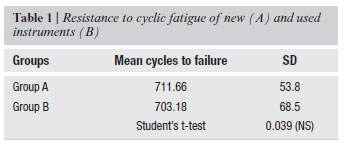
Microtomography analysis results are shown in Table 2 and the obtained images are displayed from Figures 1 to 6.
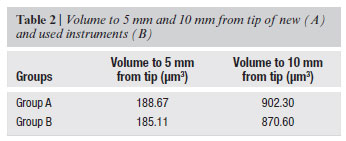
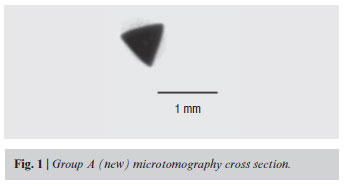



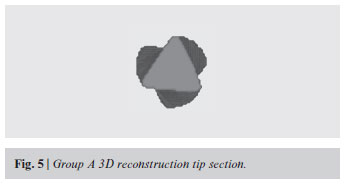
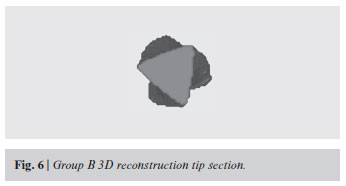
In Figure 1 it is possible to observe a cross-section of the control instruments (group A) and in Figure 2 a cross-section of the test instruments (group B).
In Figure 3 (new instrument) and Figure 4 (used instrument) it is possible to observe the 3D reconstruction of the all sample; instead in Figure 5 (new instrument) and 6 (used instrument) two 3D reconstruction tip sections of analysed instruments were showed.
DISCUSSION
The goal of the present study was to evaluate how the use of RNT instruments as "Hedstroem" files influenced metal fatigue. Results which are shown in Table 1 are very encouraging. No TF RNT instrument separated or showed any sign of flutes distortion during intracanal use. There was no statistical difference between the two groups (new vs used instruments), showing that the use of TF RNT instruments as Hedstroem files inside a straight portion of the canal resulted in an increased amount of canal enlargement with no decrease of resistance to cyclic fatigue, even if an higher rotation speed was selected to provide an increased cutting ability and debris removal.
One of the most interesting features of the present study is that the TF rotary files were operated at 1000 rpm, which is at least twice the recommended speed for the traditional use as "reamers", in order to improve their side cutting ability and allow more efficient coronal enlargement. Increasing the operating speed can be very risky when instruments are used as "reamers", since they can more easily screw inside the canal and break, but it was felt not to be a major problem when using the RNT instruments as "Hedstroem" files.
Resistance to cyclic fatigue is a critical factor for RNT instruments. When used inside a curved canal RNT instruments are vulnerable to cyclic fatigue, which is defined as repetitive cycles of compression and tension to the shank of the NiTi instrument as it rotates around a curve. Excessive cyclic fatigue can lead to intracanal failure [10]. That is why many clinicians and manufacturers suggest limiting the work of a RNT file inside a canal to only a few seconds, and state that instruments should be discarded after a single use [11]. A prolonged intracanal use (1 minute as a Hedstroem file) was also chosen to test instruments' fatigue in a very challenging clinical situation. Previous studies have shown that instruments' fatigue is also dependent on design of the NiTi files [11, 12]. Twisted files instruments were selected because they provided excellent results when subjected to cyclic fatigue tests, and consequently seemed very suitable for the suggested operative technique [9, 13].
The main explanation of the reason why in the present study no RNT instrument fractured and no metal fatigue was accumulated is that lateral cutting is provided with minimal blade engagement and tip was never blocked during intracanal use as Hedstroem files. It has been shown that the amount of engagement is directly related to RNT instruments' fatigue [1]. Moreover, since during lateral cutting the RNT instrument is operated with slight in-and-out movements the mechanical work is not always done in the same point of the working part, allowing the alloy to recover from stress induced by the cutting action.
On the other hand clinicians must also be aware that there could be a slight risk of intracanal failure of the instrument when used as a Hedstroem file, mainly because they can make a mistake by too strongly pushing the file against lateral walls during rotation, causing too much deflection of the file. It is interesting to note that even if clinicians break a file in such a way, fracture tends to occur very high up in the working part of the RNT instrument, close to the shank [7]. Such a long fragment is usually easy to retrieve from canals. Moreover the fractured portion is not locked into the canal space (clinicians must always remember that the tip must never be blocked when RNT files are being used as Hedstroem files) and is very loose.
Microtomography analysis showed a decrease in volume (small percentage) between the new instrument and the one used; indicating that during the cyclic fatigue test stress endodontic instruments are subjected to wear in the surface region; while the analysis of cross sections did not showed internal structural changes. Therefore, not significant volume changes both in quantitative and statistical analysis were observed.
Hence, we may conclude that data from the presented study confirmed that the use of TF RNT instruments as Hedstroem files is an efficient and safe procedure, since it did not significantly affected cyclic fatigue of the tested TF instruments. It was found to be a valid technique, because it can provide better coronal enlargement with minimal risk of instruments' fatigue. Such an improvement can be very helpful in easy canals, allowing to reduce the number of RNT instruments needed for canal preparation, while in the more complex cases a wider coronal enlargement allows an easier and safer progression of RNT within a crown-down sequence.
Conflict of interest statement
There are no potential conflicts of interest or any financial or personal relationships with other people or organizations that could inappropriately bias conduct and findings of this study.
References
1. Mc Spadden JM. Mastering endodontic instrumentation. Lookout Mountain TN, USA: Cloudland Institute, TN; 2007.
2. Gambarini G. The K3 rotary nickel-titanium instrument system. Endod Top 2005;10:179-82.
3. Kazemi RB, Stenman E, Spångberg LS. A comparison of stainless steel and nickel-titanium H-type instruments of identical design: torsional and bending tests. Oral Surg Oral Med Oral Pathol Oral Radiol Endod 2000;90:500-6.
4. Xu X, Eng M, Zheng Y, Eng D. Comparative study of torsional and bending properties for six models of nickel-titanium root canal instruments with different cross-sections. J Endod 2006;32(4):372-5.
5. Sattapan B, Nervo GJ, Palamara JEA, Messer HH. Defects in rotary nickel-titanium files after clinical use. J Endod 2000; 26:161-5.
6. Alapati SA, Brantley WA, Svec TA, Powers JM, Nusstein JM, Daehn GS. Proposed role of embedded dentin chips for the clinical failure of nickel-titanium rotary instruments. J Endod 2004;30:339-41.
7. Gambarini G. A rational approach to NiTi rotary instrumentation. Endodo Trib 2006;3(1):6-9.
8. Plotino G, Grande NM, Sorci E, Malagnino VA, Somma F. comparison of cyclic fatigue between used and new Mtwo Ni-Ti rotary instruments. Int Endod J 2006;39(9):716-23.
9. Gambarini G, Grande NM, Plotino G, Somma F, Garala M, De Luca M, Testarelli L. Fatigue resistance of engine-driven rotary nickel-titanium instruments produced by new manufacturing methods. J Endod 2008;34(8):1003-5.
10. Anderson ME, Price JW, Parashos P. Fracture resistance of electropolished rotary nickel-titanium endodontic instruments. J Endod 2007;33:1212-6.
11. Yao JH, Schwartz SA, Beeson TJ. Cyclic fatigue of three types of rotary nickel-titanium files in a dynamic model. J Endod 2006;32:55-7.
12. Sattapan B, Palamara JEA, Messer HH. Torque during canal instrumentation using rotary nickel-titanium files. J Endod 2000;26;156-60.
13. Gambarini G, Gerosa R, De Luca M, Garala M, Testarelli L. Mechanical properties of a new and improved nickel-titanium alloy for endodontic use: an evaluation of file flexibility. Oral Surg Oral Med Oral Pathol Oral Radiol Endod 2008;105(6):798-800.
 Address for correspondence:
Address for correspondence:
Rossella Bedini
Dipartimento di Tecnologie e Salute, Istituto Superiore di Sanità
Viale Regina Elena 299
00161 Rome, Italy
E-mail: rossella.bedini@iss.it
Received on 14 May 2010.
Accepted on 2 September 2010.
